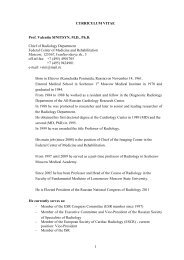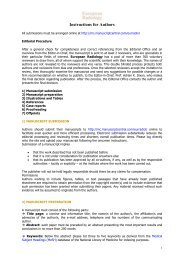Postgraduate Educational Programme - myESR.org
Postgraduate Educational Programme - myESR.org
Postgraduate Educational Programme - myESR.org
- No tags were found...
You also want an ePaper? Increase the reach of your titles
YUMPU automatically turns print PDFs into web optimized ePapers that Google loves.
<strong>Postgraduate</strong> <strong>Educational</strong> <strong>Programme</strong>A-019 16:20Surgical resection of liver metastases: when and howJ. Belghiti; Clichy/FR (jacques.belghiti@bjn.aphp.fr)Liver resection (LR) remains the only curative option for patients with colorectalliver metastases (CLM). Chemotherapy increases the possibility and the efficiencyof LR. The indication of LR is increasing to patients with multiple and bilobar livermetastases whatever their size and location if a sufficient remnant liver volume ispreserved and even to selected cases with localised carcinomatosis and/or pulmonarymetastasis. There is an ongoing debate regarding: (a) the optimal timing forLR in patients with synchronous liver metastases which can be performed before,during or after resection of the primary lesion; (b) the exact benefits of neoadjuvantchemotherapy in patients with solitary metachronous metastases; (c) the trend inextending the indications for surgery for patients with initially unresectable CLM.Increased efficiency of chemotherapy regimen using targeted therapies or intraarterialchemotherapy currently provides response rates up to 70%. Refinementsin surgical technique such as liver volume modulation using portal vein occlusionand two-step strategies allow overcoming technical issues formerly considered aslimitations to surgery. Altogether, secondary resectability can be achieved in approximately25-30% of initially unresectable patients. However, both existence ofchemotherapy liver injury following numerous cycles and complex resection in orderto achieve adequate surgical margins can impair the post-operative course andjeopardise post-operative chemotherapy. It therefore appears that these patientswould get benefit from both repeated morphological evaluation of the response tochemotherapy and more limited resection conservative strategies.Learning Objectives:1. To become familiar with surgical indications of liver metastases.2. To understand treatment planning strategies.3. To learn about prognostic factors for surgical candidates.A-020 16:35Chemotherapy and novel therapy in colorectal liver metastases:rationale, indications and resultsS. Faivre; Clichy/FR (sandrine.faivre@bjn.aphp.fr)During several decades, the only agent for the treatment of metastatic colorectalcancer was 5-fluoro-uracile (5 FU), yielding < 25% response rates and medianoverall survivals (OS) of 8-12 months. In the 1990s, oxaliplatin and irinotecan,2 major active compounds have been made available in combination with 5 FU(FOLFOX and FOLFIRI regimens), reaching #50% response rate and medianOS > 16 months. From 2005 to 2006, the introduction of targeted therapies(cetuximab-ERBITUX; bevacizumab-AVASTIN) was shown useful to optimisethe effects of FOLFOX/FOLFIRI by blocking proliferation (EGFR for cetuximab inKRas non-mutated tumours) and angiogenesis (VEGF for bevacizumab), furtherimproving OS > 20 months. Doublet and triplet chemotherapies (CT) were usuallywell tolerated. Importantly, systemic CT increases the proportion of patients whobecome candidate for liver surgery from #12% to #22%, several cases of patientswith liver metastasis being finally cured following multimodality treatments includingCT and surgery. This highlights the importance of multidisciplinary managementfor liver metastasis to offer patients the best strategy. Baseline radiologicalassessment is crucial to address surgical resectability and urge deciding for themost efficient CT regimen. Optimally, the first radiological evaluation, along withblood tumour markers, must be performed between 8 and 12 weeks. An objectiveresponse by RECIST criteria warrants continuing on the same CT if the patientremains not operable, or start planning liver resection if the patient is recognisedoperable by the multidisciplinary tumour board. In addition to tumour shrinkage,a decrease in tumour density may indicate antitumour effects for patients treatedwith antiangiogenic agents.Learning Objectives:1. To appreciate the rationale behind chemotherapy and novel therapy.2. To learn about the most common protocols of chemotherapy and novel therapy.3. To consolidate knowledge in treatment efficacy.A-021 16:50Role of image-guided treatment in colorectal liver metastasesM. Abdel Rehim, A. Sibert, V. Barrau, Z. Ben Lakhdar, V. Vilgrain; Clichy/FR(m_solouma@hotmail.com)There are more than 200,000 cases of colorectal cancer (CRC) each year inEurope. More than half of patients with newly diagnosed (CRC) will developmetastatic disease (25% synchronous, 30% metachronous). Hepatic resection isthe standard local treatment of hepatic metastases. Yet, only onethird of patientsare eligible for curative resection. Survival following hepatic resection of all metas-tases approaches 35-50%. However, approximately half of the patients will havea recurrence within 5 years. In spite of the significant progress made in systemictreatment of metastatic disease, the development of image-guided percutaneoustechniques for local tumour ablation has been one of the major advances in thetreatment of non-resectable liver and pulmonary metastases. If tumour load is stilllimited, local ablative therapy such as Radiofrequency ablation, Microwave or morerecently Irreversible Electroporation are relevant treatment options. Particularly inpatients who previously underwent surgery, minimal invasive percutaneous ablativeprocedures are preferred not only because of lower morbidity and mortality butalso because the procedure is easy to repeat in case of residual/recurrent tumour.Trans-arterial techniques are a feasible salvage treatment for chemorefractory metastaticcolorectal cancer that remains a leading cause of cancer-related death withpromising results of DC Beads loaded with doxorubicin and Irinotecan drug-elutingbeads. Although chemoembolisation represents the mainstay, 90Y microspheretherapy has recently gained increasing awareness. Last, recent studies have shownthe safety and efficacy of intra-arterial hepatic chemotherapy and percutaneousisolated hepatic perfusion in the treatment of liver metastases of colorectal cancer.Learning Objectives:1. To learn about the most common image-guided treatments.2. To understand advantages and drawbacks of each treatment.3. To become familiar with the role of image-guided treatments.Case presentation and discussion 17:0516:00 - 17:30 Room F1Professional Challenges SessionPC 3Bringing radiology to medical undergraduatesA-022 16:00Chairman’s introduction: why does it matter?S.J. Golding; Oxford/UK (stephen.golding@nds.ox.ac.uk)Today all radiologists face competing demands for their time and skills. Prioritisationhas become an essential tool of the efficient radiologist. In this scenario, itis inevitable that the greatest demand is clinical service, with the risk that otheractivity will be displaced or excluded. This Professional Challenges sessionarises from work of the ESR Working Group on Undergraduate Education. Itaddresses the need for radiologists to ensure that their involvement with medicalundergraduates is not lost due to pressure of clinical demand. The work isimportant because it ensures that: (1) medical undergraduates are equipped topractise appropriately, (2) their use of radiological resources is efficient and effective,(3) Radiology achieves a greater profile in undergraduate career choice,and (4) the opportunities that Radiology offers to support learning elsewhere inthe curriculum are realised. To achieve effective involvement, radiologists requireunderstanding of the needs of the undergraduate, the skills necessary to usetheir time efficiently, knowledge of which of the available educational optionsare appropriate to the speciality, and the skill and ability to maintain Radiology’svoice in curricular planning and medical school direction. These presentations,from leaders in radiological education, are intended to assist the teaching radiologistin their efforts to make such an impact on the medical undergraduate.Session Objectives:1. To understand why radiologists need to make undergraduate teaching a priority.2. To become familiar with the effect of teaching undergraduates on the studentand the institution.3. To appreciate the objectives with which the undergraduate should be taught.A-023 16:05Establishing a radiological presence in the undergraduate curriculumR.N. Gibson; Melbourne/AU (r.gibson@unimelb.edu.au)Establishing a radiological presence in the undergraduate medical curriculum embedsthe perception of a specialty which is pivotal in medical education, health caredelivery and research. It also attracts students into radiology. <strong>Educational</strong> outcomesrelate to: (a) imaging as a learning tool for anatomy, pathology, and clinical medicine(b) the principles and practice of radiology (image generation and interpretation,procedural radiology, interpretation skills for common or life-threatening conditions,diagnostic accuracy, referral guidelines, and the consultative process, safety andrisk, cost and resource management, and the patient experience of diagnosticand procedural imaging). Gaining a curricular presence requires: (a) proactiveengagement with university and clinical campus leaders in developing explicitS10AB C D E F G













